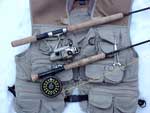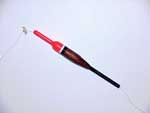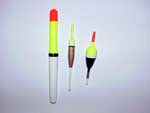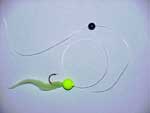Spin or Fly for Early Steelhead?

By Mark E. Brown
 Spin verses Fly... Both these presentations will catch fish on a consistent basis...but in the early spring I think the Spin Drift system out performs a Fly pattern. The early spring rains combined with snowmelt, transform Great Lakes tributaries to vehement torrents of chocolate milk. This can make fishing Steelhead difficult at times. We know the fish are there, but finding and hooking is not always an easy proposition. Spin Drift Fishing may be the answer during these high water periods. Later in the year as the water levels begin to stabilize and river waters clear, a fly presentation is by far the better choice. Spin verses Fly... Both these presentations will catch fish on a consistent basis...but in the early spring I think the Spin Drift system out performs a Fly pattern. The early spring rains combined with snowmelt, transform Great Lakes tributaries to vehement torrents of chocolate milk. This can make fishing Steelhead difficult at times. We know the fish are there, but finding and hooking is not always an easy proposition. Spin Drift Fishing may be the answer during these high water periods. Later in the year as the water levels begin to stabilize and river waters clear, a fly presentation is by far the better choice.
Steelhead of the Great Lakes...
Before starting to gear up for winter and early spring steelheading, fishermen should have some understanding of the steelhead's seasonal movements. The Great lakes region is host to four strain of Steelhead (Rainbow Trout)… Skamania, Ganaraska, Chambers Creek and Little Manistee. All four species (or) strains are subject to a primal biological clock. This gives them no recourse other than to return to their rivers of origin as nature dictates. However, not all species of steelhead introduced to the Great Lakes region return to run the rivers at the same time each year.
Ganaraska strain, enter the tributaries in January under the ice, and begin their exodus in mid to late May. This is the strain of Steelhead most often caught late winter and very early spring. Skamania, Mid-to-late May this strain of steelhead begin to stack up at the mouth of their river of origin. These Steelies then begin the spawn run in early June, and stay in the rivers most of the summer, moving back to the lake towards the end of September. Chambers Creek strain, move up the tribs mid-to-late fall and stay well into January of the following year. Chambers Creek strain account for most of the Steelhead caught during the late fall run. Little Manistee, are also a late fall spawner, entering the tributaries early to mid October, and staying well after ice-out the following year... Well as you can see, Steelhead fishing on our Great Lakes Tributaries is for the most part, a year around affair. Now lets examine the Gear and a few techniques most commonly used with Winter Steelhead Drift methods of fishing.
Gear & Tactics...
Winter/early spring fishing requires some special gear; 5mm neoprene waders are a standard, and at least 3mm neoprene gloves as well. A hooded Gore-tex© coat tucked into your waders will keep you warm and dry all day, even in the most adverse weather. Remember, the water temperature is 33 to 40 degrees and the air temperature may be in the 20-degree range. With this in mind, it's important to protect all exposed skin. I don't recommend wading the rivers at this time of year if it can be avoided. But, if we must enter the river, the fore mentioned gear is an absolute must!
Drift System Rods and Spinning Reels…
 Most manufacturers spinning rods will work for the winter steelhead drift fishing system, as long as the rod meets these three important criteria: 1. Heavy / Stiff butt section. 2. Sensitive tip section. 3. At least (9') in length or longer. I highly recommend a longer rod for this Drift system fishing. I feel a 9-11ft. rod is the way to go. These longer rods create a fulcrum which allows the fisherman much better line control, as well as keeping the slack line off the water during the drift. If the line is allowed to dip below the surface, the current will ultimately drag it down, thus spoiling the dead drift we are trying to maintain. The use of paste floatents is also recommended. I use Gink© dry fly dressing, although any dry fly dressing will work. Smear 10-12ft. of the line just above the Drift float. This helps to keep the slack line from sinking below the surface. Remember, a Dead Drift presentation is mandatory for this fishing system to work. It's that one component which makes this Spin Drift Fishing System so very effective. Most manufacturers spinning rods will work for the winter steelhead drift fishing system, as long as the rod meets these three important criteria: 1. Heavy / Stiff butt section. 2. Sensitive tip section. 3. At least (9') in length or longer. I highly recommend a longer rod for this Drift system fishing. I feel a 9-11ft. rod is the way to go. These longer rods create a fulcrum which allows the fisherman much better line control, as well as keeping the slack line off the water during the drift. If the line is allowed to dip below the surface, the current will ultimately drag it down, thus spoiling the dead drift we are trying to maintain. The use of paste floatents is also recommended. I use Gink© dry fly dressing, although any dry fly dressing will work. Smear 10-12ft. of the line just above the Drift float. This helps to keep the slack line from sinking below the surface. Remember, a Dead Drift presentation is mandatory for this fishing system to work. It's that one component which makes this Spin Drift Fishing System so very effective.
A Spinning Reel is also an important component of the Drift fishing system. Like the rod, the reel must also meet a few prerequisites: It must hold at least 180 yards of 8-10# test monofilament line, and have a smooth drag system. I much prefer a spin cast reel which has been designed for salt water use. These reels offer all metal construction and a very smooth drag. You may find these reels to be a bit more expensive than their freshwater counterpart, but to this fisherman, these reels are well worth the money.
The Drift Rig itself...
 The simpler we keep these components of the system the better it will work... Ok, moving down the line. Using the spinning reel spool as a start point, we first come to the Float stop. I have found tying a piece of rubber band to the line just above the stick float is not only economical, but will not mar or weaken the monofilament line in anyway. A rubber band tied with the double granny knot pulled tightly, will support a great deal of weight. It can also be adjusted easily to any depth required. The simpler we keep these components of the system the better it will work... Ok, moving down the line. Using the spinning reel spool as a start point, we first come to the Float stop. I have found tying a piece of rubber band to the line just above the stick float is not only economical, but will not mar or weaken the monofilament line in anyway. A rubber band tied with the double granny knot pulled tightly, will support a great deal of weight. It can also be adjusted easily to any depth required.
Continuing down the line .Just after the Float stopper, we find of course, the Float. If you have ever shopped for floats then you know just how numerous a selection there is. It would seem someone has developed a float for every conceivable situation a fisherman could encounter. But for our purposes, the following three styles are sufficient.
- The Fast water Float is a good choice for drifting the heaviest current through the gut or main river channel.
 The Slow water Float, is a good choice for close to the banks or deep pool tail-out with a slow to moderate flow. The Slow water Float, is a good choice for close to the banks or deep pool tail-out with a slow to moderate flow.- Moderate to fast water Floats, are a good choice for the long runs just before gravel bars or river bend pools and eddies. You will notice these stick floats are designed to slip the line through the body. I use this style for the simple reason that the line exits the top of the float making it much easier to keep the line off the water. This type of float also can be cast with the accuracy of a bullet.
Ok, still moving down the line, we now come to the meat & potatoes of this system. The Weight and Rig.
As with all drift systems, we will need to apply weight in order to get our presentation down to the fish. The amount of weight required will depend upon depth of water and rate of flow. I start with 1/4 once split shot, then add or subtract weight as needed to keep the fly or spawn in the feeding zone. We want to maintain the all important tic-tic-tic as the bait bounces along the bottom. Watching experienced Drift method fishermen, you will notice they are continually making adjustments to the float and weight to achieve and maintain the tic-tic-tic...
 The Drift rig shown here, has proven to be by far the most productive for me on the Great Lakes tributaries. Using a #2 Egg Hook, tie on a 3 or 4 in. piece of glow-yarn (chartreuse), and push a yellow cork egg over the eye of the hook. Now you're ready to drift this rig. I originally developed this drift rig with the intention of tipping it with spawn or a river shiner, but found it to work much better as is... Well, I'll leave that for you to decide. The next time you're out after Steelhead on the Tribs. give this Drift System a try. I'm sure you won't be disappointed. The Drift rig shown here, has proven to be by far the most productive for me on the Great Lakes tributaries. Using a #2 Egg Hook, tie on a 3 or 4 in. piece of glow-yarn (chartreuse), and push a yellow cork egg over the eye of the hook. Now you're ready to drift this rig. I originally developed this drift rig with the intention of tipping it with spawn or a river shiner, but found it to work much better as is... Well, I'll leave that for you to decide. The next time you're out after Steelhead on the Tribs. give this Drift System a try. I'm sure you won't be disappointed.
Tight lines...
Click on any of the above photos for larger version,
remember to use your browser's back button to return.
|
|

